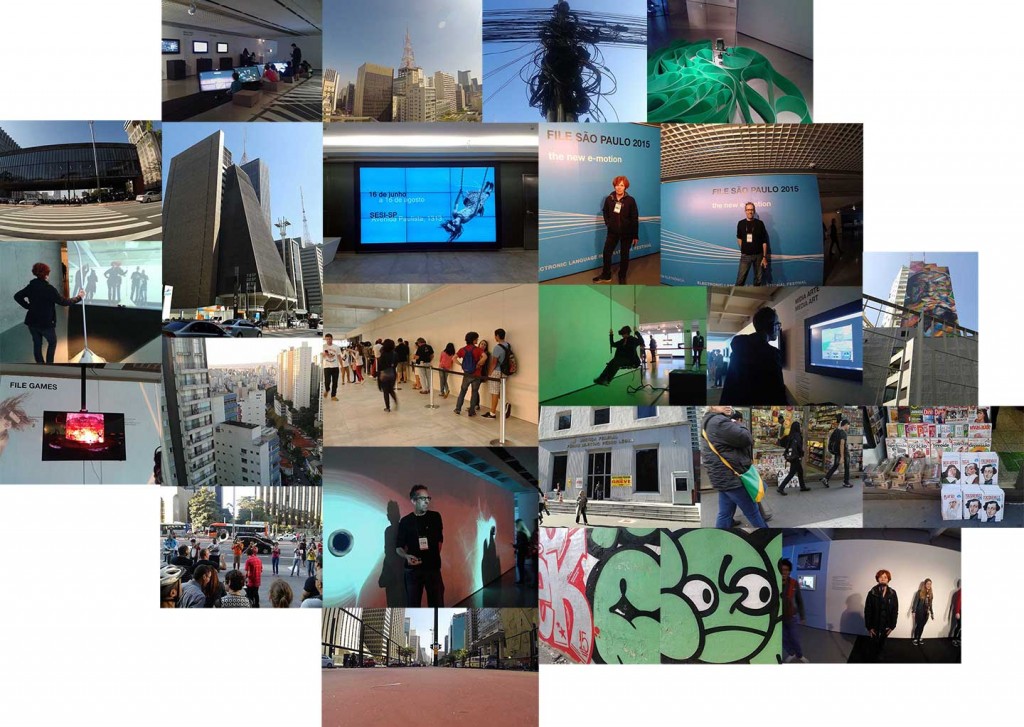Notes de terrain – São Paulo (2015)
J’ai eu l’occasion de me rendre à São Paulo en compagnie de Valerie LeBlanc où nous présentions au festival FILE 2015 une vidéo issue de notre projet FLOW : BIG WATERS. Ce voyage a été une occasion de rencontres et de réflexion. Voici deux événements, deux moments qui m’ont marqué.
L’heure de Brasilia : nous ne sommes pas seuls
L’heure de l’Atlantique donne souvent l’impression d’être isolé du monde. Sur la carte des fuseaux horaires de l’Amérique du Nord, les provinces maritimes semblent être à l’écart, et ce même si plusieurs îles des Caraïbes font partie de cette zone. Cette isolation n’est pas néfaste en soi, elle a contribué à définir le caractère unique des habitants de la région. Comme on le dit : There are good times, there are bad times and there are the Maritimes.
Lorsque je suis arrivé à São Paulo, je me suis vite rendu compte qu’il n’y avait pas de décalage horaire. Au Brésil, l’heure de l’Atlantique porte un autre nom, c’est l’heure de Brasilia. Tout à coup, je sentais l’énergie humaine de toute la ville battre à l’unisson avec les Maritimes. Nous n’étions plus seuls. Nous nous levions à la même heure, nous mangions en même temps, l’heure de pointe était la même dans les deux zones. Nous et la métropole de l’Amérique latine.
Il faudrait toutefois préciser que notre cohabitation n’est pas une condition permanente : nous vivons dans la même zone du mois de mars au mois d’octobre. Lorsque l’heure de l’Atlantique bascule de l’heure d’été à l’heure d’hiver et que l’heure de Brasilia fait la même chose, mais inversement, notre synchronisme euphorique, cesse. Mais rien n’est perdu, comme l’état de l’Amazonas n’observe pas l’heure d’été nous pouvons continuer de rêver en nous rattachant cette fois à Manaus et au temps immuable de l’heure de l’Amazone.

Réalité virtuelle vs réalité actuelle : nous sommes seuls
São Paulo est une grande ville. Une ville Big Bang qui s’étend de tout côté. Le soleil plombe sur l’avenue Paulista, l’air est rempli d’odeur subtile. La musique émane d’un peu partout. Une motocyclette passe, un homme appuyé contre une balustrade écoute une partie de football sur son petit transistor. Il sourit. Les ondes radio nous enveloppent.
São Paulo, la ville sans publicité, est recouverte de graffitis, d’alphabets inconnus, de jets d’encre explosifs. Il n’y a pas de Ralph Lauren, pas d’images de BMW, seulement une succession de tags mystérieux. Une tête verte aux yeux argentés nous regarde.
Les musées et les galeries d’art semblent être bondés en permanence. Les files d’attente s’étirent comme des rubans d’ADN. L’exposition FILE 2015 ne fait pas exception. Le public est au rendez-vous. L’œuvre qu’on retrouve sur la couverture du catalogue porte le nom de SWING, une installation immersive où les spectateurs sont invités à utiliser une balançoire pour découvrir un monde nouveau. L’opératrice, une bénévole, invite les spectateurs à s’asseoir en s’assurant que les lunettes stéréoscopiques sont bien en place. Elle met en marche l’application chronomètre de son iPhone (chaque spectateur a droit à deux minutes) et retourne s’asseoir sur sa chaise. Comme j’attends mon tour pour aller me balancer, j’observe autant ceux qui sont sur la planche que l’opératrice. Pendant que les secondes du chrono disparaissaient, elle est occupée à échanger avec ses amis sur Facebook. Elle envoie des messages textos de façon endiablée jusqu’à ce qu’un petit son de cloche la ramène au devoir. Elle se lève et s’occupe du transfert de spectateurs.
Il y avait quelque chose d’étrange, de la voir et de nous voir vivre des choses si différentes. Nous (dans le monde 3D de l’impossible futur) et elle (dans le quotidien de ses échanges). Il était impossible de savoir si nos trajectoires allaient se croiser ou si nous allions rester seuls dans chacune de nos bulles.
*

FILE 2015
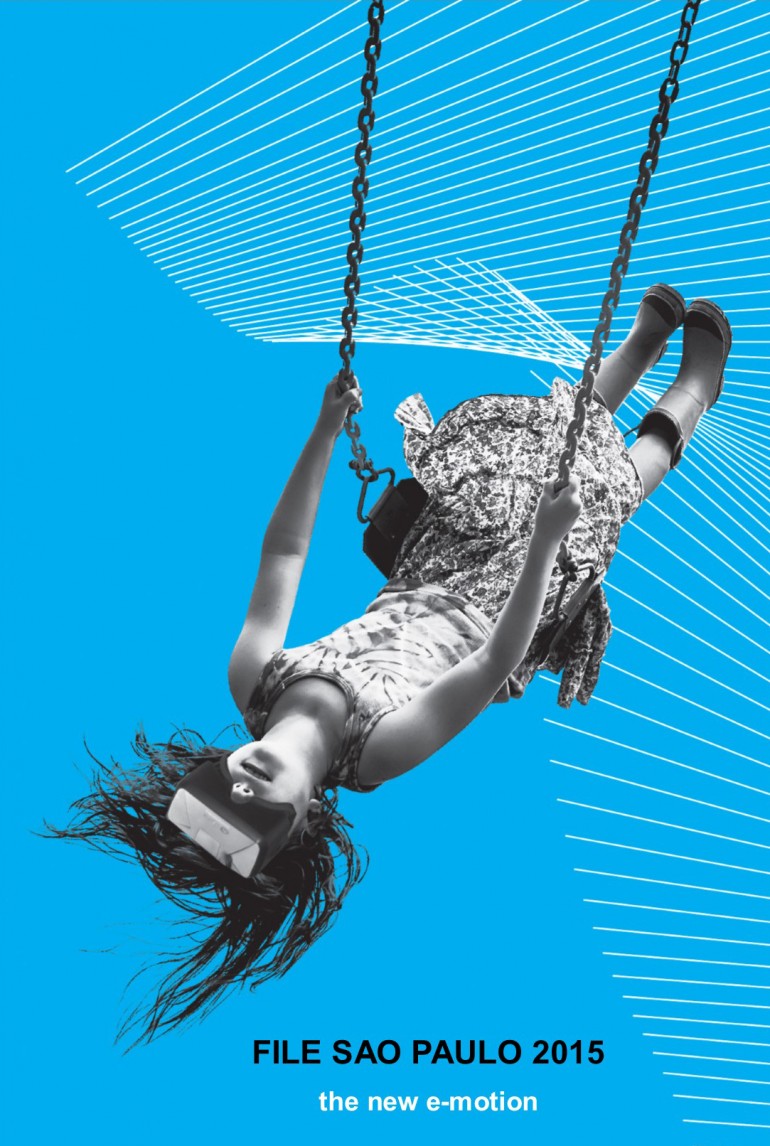
We are very happy that our FLOW: BIG WATERS video program will to screened during FILE 2015!
FILE SAO PAULO 2015 – PROGRAM
FILE São Paulo 2015
the new e-motion
From June 16th to August 16th
FILE 2015 – Electronic Language International Festival takes place this year from June 16th to August 16th at Centro Cultural FIESP – Ruth Cardoso. In its 16th edition, the festival occupies the Art Gallery of SESI-SP, the Digital Art Gallery (the facade of the FIESP building) with the FILE LED SHOW, and the Mezzanine Floor, where a series of workshops takes place. The festival exhibits the interactive installation “Solar Pink”, by the North American group Assocreation, in the sidewalks of Avenida Paulista, and the installation “Arart” in the subway stations Trianon-Masp and Consolação. Created by Japanese artists Takeshi Mukai, Kei Shiratori and Younghyo Bak, this work creates dynamics in iconic art history paintings using an app for mobile devices.
The FILE 2015 exhibition, that takes place at the Art Gallery of SESI-SP, gathers artistic proposals in several forms such as interactive installations, games for multiple platforms, animations, video art, GIFs, WebGLs, web art and electronic sounds.
The festival also exhibits a projection subtitled in Portuguese of the award-winning movie “Shirley – Visions of Reality”, directed by Austrian filmmaker Gustav Deutsch, a contemporary cult cinema icon. Never shown before in Brazil, the film is based on 13 paintings by American painter Edward Hopper.
The participation in all activities of FILE 2015 is free
MEDIA ART
1 Anne Pasanen & Geo Panagiotidou-Kalevala Book Visualisation-Finland
2 Anni Garza Lau – A Pragmatic Digital Art Manifesto-Mexico
3 Basic Bruegel: Valerie LeBlanc & Daniel H Dugas-Flow: Big Waters–Canada
4 BiarritZZZ-Possawsubawater-Brazil
5 Chang Liu-Wild Growth-United States
6 Daniel Peixoto Ferreira-Join Us-Brazil
7 Daniel Peixoto Ferreira-Learn-Brazil
8 David Clark-The End: Death in Seven Colours– Canada
9 Duda-Ecos #1-Brazil
10 ENRIQUE FRANCO LIZARAZO – D-sonus: aplicativo para criação audiovisual em dispositivos móveis – Brazil
11 Ewa Doroszenko & Jacek Doroszenko – Soundreaming – Poland
12 Hidenori Watanave Laboratory, Tokyo Metropolitan University, The Asahi Shimbun Company & Tokyo Metropolitan Archives – The Tokyo Olympic Archive 1964-2020 – Japan
13 Iono Allen – Butchery – France
14 IP Yuk-Yiu – Clouds Fall – Hong Kong
15 Jason Edward Lewis – Vital to the General Public Welfare (The PoEMM Cycle) – Canada
16 Jason Nelson – The Required Field – Australia
17 Jean-Michel Rolland – Biosphere – France
18 Jean-Michel Rolland – The Endless Journey – France
19 Jenny Lin – Replay: A Memory Game – Canada
20 Jody Zellen – Time Jitters – United States
21 jtwine – UltraHyperDrone – United States
22 Justin Lincoln – The Stroboscope – United States
23 Les Riches Douaniers: Gilles Richard & Fabrice Zoll – Tableau Sisyphéen (Sisyphean Picture) – France
24 Livia Mateiaș – Strings – Romania
25 Luigia Cardarelli – Landscape – Italy
26 Luigia Cardarelli – The Unspoken Words – Italy
27 Luigia Cardarelli – Imagined Time – Italy
28 Luis Hernandez-Galván – This place you see is about to be no more… – Singapure
29 Michael Takeo Magruder – Data_Plex (Babel) – United Kingdom
30 Paganmuzak – Rotational Chaos – Italy
31 Rachel Simone Weil, Torley & Nathalie Lawhead – Monkey Fortunetell – United States
32 reVoltaire – kinema ikon: serial / season one – Romania
33 Roberto Stelzer – Poesia 3D – Brazil
34 Ryota Matsumoto – the High Overdrive and Its Undefinable Consequence – Japan
35 Ryota Matsumoto – the Indistinct Notion of an Object Trajectory – Japan
36 Ryota Matsumoto – Voided by the False Vows of Time – Japan
37 Second Front: Patrick Lichty, LiZ Solo, Bibbe Hansen, Yael Gilks, Doug Jarvis & Scott Kildall – Red Dog For Freddie Herko – United States
38 Will Luers – Phantom Agents – United States
AnthropoScene Schedule (2015)
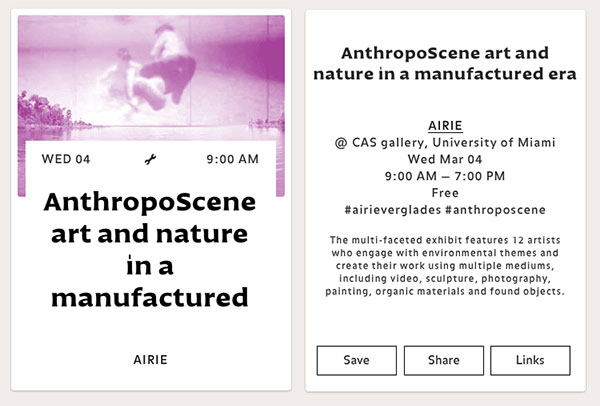
Exhibition March 4 – 24
CAS Gallery. 1210 Stanford Drive. Coral Gables, FL
Panel Discussion March 4 9am-12pm
Ungar Building 230 C/D. 1365 Memorial Drive
Lunch/Gallery Tour March 4 12:30-1:30 pm
CAS Gallery. 1210 Stanford Drive. Coral Gables, FL
Workshops March 4 2-5 pm
CAS Gallery. 1210 Stanford Drive. Coral Gables, FL
Opening Reception March 4 5:30-7:30 pm
CAS Gallery. 1210 Stanford Drive. Coral Gables, FL
SCHEDULE OF EVENTS
MARCH 4
PANEL DISCUSSION
UNGAR 230 C/D. 1365 MEMORIAL DRIVE. CORAL GABLES. FL
with artists
Daniel Dugas
Felice Grodin
Valerie LeBlanc
Lucinda Linderman
Deborah Mitchell
Skip Snow
Keith Waddington
8:30 am – 9:00 am Registration/Coffee Service
9:00 am – 9:15 am Welcome and plan for day: Gina Maranto and Keith Waddington
9:15-9:45 am Opening remarks: Skip Snow
9:45-10:00 Keith Waddington
10:00-10:30 Valerie LeBlanc and Daniel Dugas
10:30-10:45 Skip Snow
10:45-11:00 Break
11:00-11:30 Deborah Mitchell
11:30-12:00 Discussion with all artists moderated by Felice Grodin and Lucinda Linderman
WORKSHOPS AND EXHIBITION OPENING
CAS GALLERY. 1210 STANFORD DRIVE. CORAL GABLES. FL
with artists
Daniel Dugas
Felice Grodin
Valerie LeBlanc
Lucinda Linderman
Susan Silas
Skip Snow
Keith Waddington
12:30 pm – 1:30 pm Buffet Lunch and Tour
(Tour at 1 p.m.)
2:00 pm – 5:00 pm Concurrent workshop sessions
5:30 pm – 7:30 pm Opening reception: anthropoScene exhibition
anthropoScene is a semester-long exploration of this new era sponsored by the Leonard and Jayne Abess Center for Ecosystem Science & Policy and the College of Arts and Sciences of the University of Miami with participation by Artists in Residence in the Everglades.
Miami Report – Valerie LeBlanc and Daniel Dugas (2014)
Report from a visit to Miami and the Everglades National Park – Valerie LeBlanc and Daniel Dugas, November 2014
Our visit to South Florida to screen video poetry at the Miami Book Fair International and a visit to the Everglades National Park was short. Aside from the two days of air travel, we were there for just three days, really full days! To begin, on November 18, we screened several videos and took part in a panel discussion on the transformative effects that the July 2014 AIRIE (Artist In Residence In Everglades) residency had on our work. While our FLOW: BIG WATERS everglades-based project is ongoing and will eventually include an installation with soundwalks and photographs, we were happy to screen a selection of the video works that we have completed to this date.
The panel discussion was co-moderated by Artist and AIRIE Executive President, Deborah Mitchell and Biologist Skip Snow. The five AIRIE Artists who presented and took part in the discussion were: Gustavo Matamoros, Reed van Brunschot, Author Anne McCrary Sullivan, and ourselves. After brief introductions by Deborah Mitchell, Miami historian Dr. Paul George opened the conversation with details about the current and recent landmarks that stand and stood close to the Book Fair venue we were sitting within. Downtown Miami is undergoing many physical changes as new buildings replace older structures. Dr. George’s comments brought some of these changes to light. The evening took place at the SWAMP; the pop-up lounge utilized for showcasing social and cultural events during the Miami Book Fair International on the Miami Dade College, Wolfson Campus.
After the AIRIE presentation, Gustavo Matamoros and his partner, Miami-based Graphic Artist Claudia Ariano invited us to drive over to Little Havana’s El Cristo Restaurant to experience Cuban cuisine. The conversations continued in a range of topics that ran from contemporary art through a variety of cultural markers.
During two of our days, we walked around the Wolfson Campus and Miami’s downtown to become somewhat oriented with the city. We found our way over to the Miami Beach Mall for the opening of an umbrella of exhibitions at the ArtCenter of South Florida. The open studios and exhibitions for the 30 Years on the Road show spread out from 924 Lincoln Road, along the block to transform the experience from indoor venues to vitrines for sidewalk viewing. It is an ambitious undertaking that showcases retrospective and contemporary artworks embodying many genres. Outside of 924 Lincoln, the Listening Gallery, in partnership with Subtropics.org is presenting the collaborative work: Walk-Run. On opposite sides of the entrance doors, Walk-Run features face to face moving images by Charles Recher. Combined with a soundscape by Rene Barge and Gustavo Matamoros, Walk-Run can be experienced differently depending on if you are up-close to it, on the sidewalk in front of the building, or at distance. Turning the corner to view other artworks presented in vitrines also permits variable exposure to the audio as the sound waves bend around the architecture of the cityscape. Owing to the nature of showing so many artists at one time, the opening reception moved along the block with conversations continuing inside in and outside of the studios. Walking this stretch of the Mall with Gustavo, we met and talked with many artists. We also took time to view examples of art deco along the Lincoln Road Mall.
On November 20, the final day of our visit, Deborah Mitchell invited us to drive out to the AIRIE lab to visit November’s resident artist Regina Jestrow. Regina had generously organized an open studio reception in the lab where she laid out a sampling of the research she carried out during the month. It was a chance to talk informally with Regina, the other artists and scientists who dropped by, and several of the Park Staff that we had the pleasure of working with during July. We saw the beginning stages of Regina’s artworks utilizing imprinted rubbings and look forward to seeing the next stage of this new textile based work.
Back in Miami the same evening, we visited the Locust Project. Showing in the Main Space is Daniel Arsham’s Welcome to the Future. In the project room,Salvadorian artist Simón Vega’s exhibition Sub-Tropical Social Sculptures is ongoing.We arrived in time for the Art on the Move presentation with Curator Dominic Molon in conversation with Vancouver-based artist Ron Terada. The subject of the discussion was Terada’s Soundtrack for an Exhibition.
Our on-the-ground introduction to the Miami art scene gave us the chance to scratch the surface of this diverse, multicultural city where Spanish is the predominantly spoken second language. Staying in downtown Miami gave us the chance to see the last days of the old Miami Herald Building as it underwent demolition. It will be interesting to go back and see what new masterpiece rises to replace it on Biscayne Bay. If one word could be used to describe the face and evolving culture of Miami, vibrant would fit!



This activity was supported by the New Brunswick Arts Board


And the MBFI / The Swamp

Miami Book Fair International (2014)
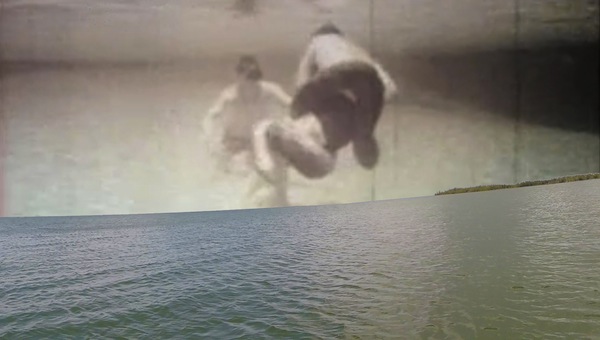
An Evening with AIRIE (Artists in Residence in Everglades)
Miami Bookfair International 2014
Tuesday, November 18th @ 7pm at The Swamp Pavillion
Look for the big tent at the southeast corner of N.E. 3rd Street and 2nd Avenue.
Science + Art: Transformative Experiences in the Everglades
Despite its importance, abundance of wildlife, and great natural beauty, many people have never visited the Everglades and only have a vague idea of it as a tangled swamp rife with pythons, mosquitoes and alligators. AIRIE executive director and artist Deborah Mitchell and biologist Skip Snow will co-moderate a panel of five AIRIE artists on the transformative experience their residency in the Everglades has had on their work. Audio composer Gustavo Matamoros, Visual artist Reed Van Brunschot, author Anne McCrary Sullivan, and multi-disciplinary Canadian artists Valerie LeBlanc and Daniel Dugas will share their recent experiences with the audience while a slide show of AIRIE art provides visual support for their moving narratives.
About the artists
LeBlanc and Dugas will debut their new project FLOW- BIG WATERS with a program of video poems. Based upon their research in the Everglades National Park, the project will continue through 2015 and will also include a series of sound walks and photographs. Researching and recording several aspects of this unique biosphere, this dynamic duo continues working on various aspects of this multi-facetted project. Using tools of writing, still and moving images and audio, the root of their desire is to share the aesthetic joy of being there in the moment. When completed, the project will be available online.
Matamoros will present Bats & Insects, a sound-scape audio composition on exhibit September 19-November 5th at the critically acclaimed Common Ground: Artists in the Everglades at Florida Atlantic University. This Venezuelan composer is the driving force behind ISaw + Subtropics, the leading proponent of experiential music and sound art in the Southeast.
McCrary Sullivan has had poems widely published in literary and academic journals including The Gettysburg Review, the Southern Review, and Harvard Educational Review. During and after her AIRIE residency, she accumulated thousands of hours paddling the waters of the Everglades National Park, which resulted in two books: Ecology II: Throat Song from the Everglades and Paddling the Everglades Wilderness Waterway.
Van Brunschot is a visual artist who uses multiple mediums including sculpture, painting, performance and video. Based on evoking memories of childhood, home life and a general commonality found in nostalgic experiences, her work examines transitions and places them in the public sphere. Van Brunschot will discuss how her recent transformative residency experience has affected her studio practice.
About the Moderators
Biologist Skip Snow worked for the National Park Service for 38 years, the last 25 at Everglades National Park. He has evaluated the effects of water management on park wildlife, worked to reintroduce native species, and spent considerable time working on eradicating the Burmese python. Since retiring in 2013, Skip has been pursuing a keen interest in the intersection of art and science, and continues to volunteer for the park as an emeritus wildlife biologist.
Artist and Executive Director of AIRIE, Deborah Mitchell, participated in the Artist-in-Residence program in Big Cypress in 2007. Since then, environmental awareness and community outreach has been the focus of her multi-disciplinary work. In addition to working with AIRIE fellows and organizing cultural programs, she curated The Preserve in 2012 and Flight: Aloft in the Everglades in 2014. Mitchell’s photographs can be seen in Swamplife, (Minnesota Press).
An evening with AIRIE in the Swamp Pavilion at the Bookfair will be an informative program which presents a nuanced look at the Everglades by letting AIRIE Fellows share their work and perspectives on the park with both local and international book lovers.
http://airie.org/2014/save-the-date-airie-at-the-book-fair-nov-18/
Everglades reverberations (2014)

The following writeup was originally published on the Knight Arts website on July 25th 2014
By Daniel Dugas and Valerie LeBlanc, AIRIE
We came from the north. As we approached Miami, the pilot said something about the weather while swerving to miss storm cells. A few hours later, after we had landed, the downpour started in earnest. The rain was heavy, the sky black. It was a big storm; actually it was the first tropical storm of the 2014 Atlantic Hurricane season. It later strengthened to become Hurricane Arthur and it was tracking northward. Hurricanes often follow the Gulf Stream current and affect the Maritime region of Canada where we live. But this one was going for the jugular; our town was right in the middle of its path. There were a slew of warnings posted on the Environment Canada website, tropical storm, rainfall, wind, special weather statement, and a tropical cyclone information statement. We followed the evolution of Arthur and worried for our house. At the last moment the storm veered left and the town where we live got a good soaking but not the anticipated deluge. It was pretty amazing to arrive in Florida just in time to witness the birth of a storm that slowly moved northward to die almost outside of our doorstep. It was a reminder of the interconnectedness of all things.
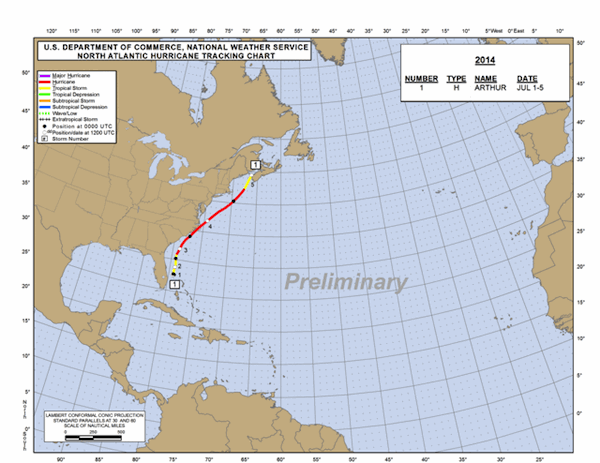 Hurricane Arthur, July 5, 2014, National Hurricane Center
Hurricane Arthur, July 5, 2014, National Hurricane Center
We are here to do a soundwalk project; fictional stories, voices, swamp recordings. It is this concept of interconnectness that is calling for our attention. We are looking at the connections between: the Everglades National Park geography and its inhabitants; those living close to its borders; and those, like ourselves, who come here to commune with the environment. We recognize that ecologically speaking, our understanding and experience of the Everglades is a relatively short moment in time. As we research through the networks and components that is the Everglades, we try to understand something of where it all sits in the grand scheme of things.
Upon arriving, the first thing that we did was to try to visualize the park, to construct a mental chart of what exists where. In the first few days we covered as much ground as we could, recording ambient sound, the weather, and the insects. The mosquitos hit the shotgun mic with anger. We saw sunrises, sunsets, walked in the warm waters of the slough at Pa-Hay-Okee, attempted to hike among the mangroves at Christian Point Trail, immersed ourselves in the song of crickets, frogs, of rustling in the bush, of movement in the trees.
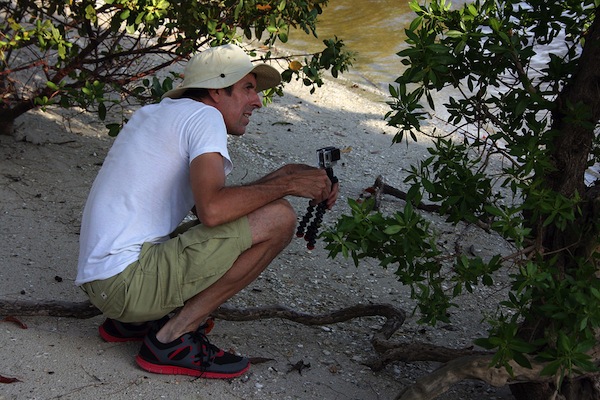 Daniel, Chokoloskee
Daniel, Chokoloskee
The type of collaboration that we do is diverse. We have been collaborating for over twenty years on many projects. Often we work within a framework that allows for individual sensitivities to bubble to the surface, this is the case with our Everglades project. As we go out on hikes and explorations we experience the same location but from two different perspectives. Our individual takes are like stones thrown into a lake; the ripples of both, the points on intersections lie where the waves combine. That is often the place of creation.
Soon after arriving, we realized that we were in a world of layers. That we would have to see through the mosquito layer, the mosquito net layer, the humidity layer, the heat stress layer and the DEET layer. Every task becomes monumental, every clap of thunder, every raindrop intensifies, maximizes the experience.
We quickly learned to operate in the environment, to be there. Because audio recording demands silence and stillness, it is an obvious target for the hordes of skitters. In the spirit of adaptation, Valerie developed a Tai-Chi-like series of movements to repel them away from the microphone pickup area. This slow motioned waving of blue rubber gloved hands became the symbol of a certain level of peace.
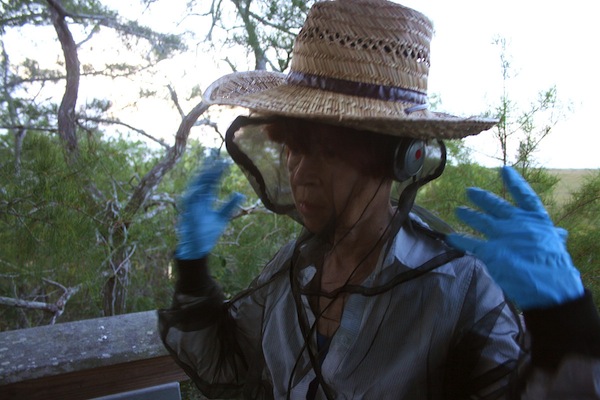 Valerie’s Tai-Chi-like series of movements, Pa-Hay-Okee
Valerie’s Tai-Chi-like series of movements, Pa-Hay-Okee
Of all the layers present within the Park, it is the human presence that has become the focus of our work. Whether it is the recently abandoned Chekika Day Use Area, the HM69 Nike Missile Base,
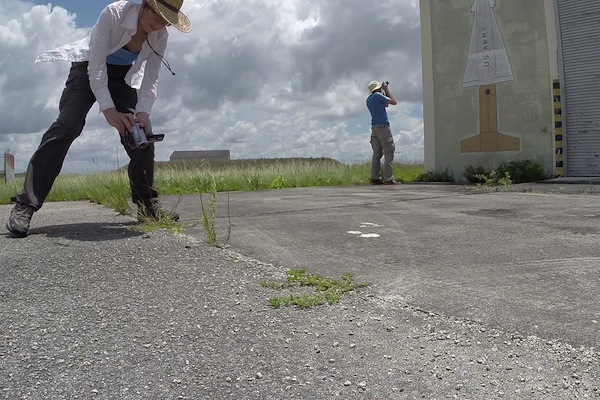 Valerie and Daniel, HM69 Nike Missile Base
Valerie and Daniel, HM69 Nike Missile Base
the shell mounds of the Calusa Indians on Sandfly Island or the Deer Pen ruins near Paradise Key, all of these traces reveal something about human interventions in this place. Trace elements become covered, overgrown, eaten or corroded as plants, animals and climate reclaim. Sites can be seen as momento mori, reminders of mortality, but they are also reverberations of life.
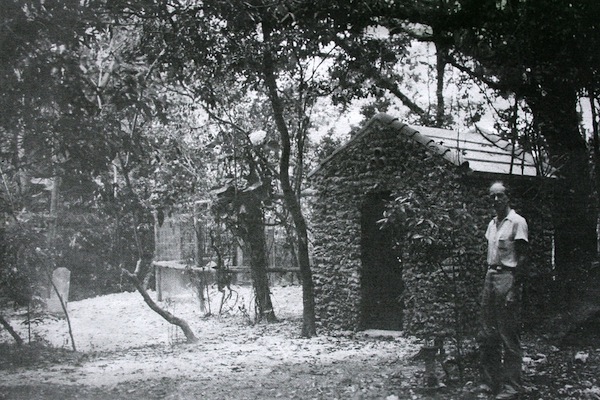 Deer Pen, Paradise Key, NPS archives July, 1934
Deer Pen, Paradise Key, NPS archives July, 1934
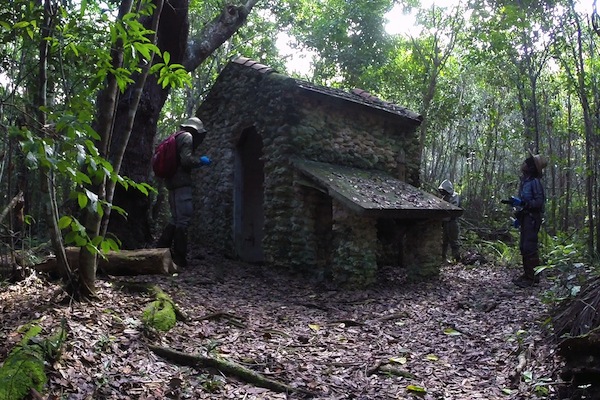 Deer Pen, July 2014, left to right: Daniel Dugas; Hillary Cooley, Botanist, Everglades and Dry Tortugas National Parks and Valerie LeBlanc
Deer Pen, July 2014, left to right: Daniel Dugas; Hillary Cooley, Botanist, Everglades and Dry Tortugas National Parks and Valerie LeBlanc
Announcing 2014 AIRIE Fellows
Valerie LeBlanc and myself are extremely happy to have been invited by the Everglades and Dry Tortugas National Park to be the artists in residence for July 2014. It is a prestigious opportunity and referring to the tradition of invited artists, as stated in the 1st paragraph of the letter, ‘our work there will become part of the permanent record of the parks that helps to preserve them’. Described as a subtropical wilderness, with a unique combination of temperate and tropical characteristics, the Everglades has been designated as a World Heritage Site, an International Biosphere reserve, and a Wetland of International Importance. One of the main outcomes that the Park hopes to gain from the visiting artists is ‘to help visitors make emotional and intellectual connections with this amazing place’. As per our practice(s), we are looking forward to continuing to create poetic storylines within the exploration of this new media locative soundwalk project.
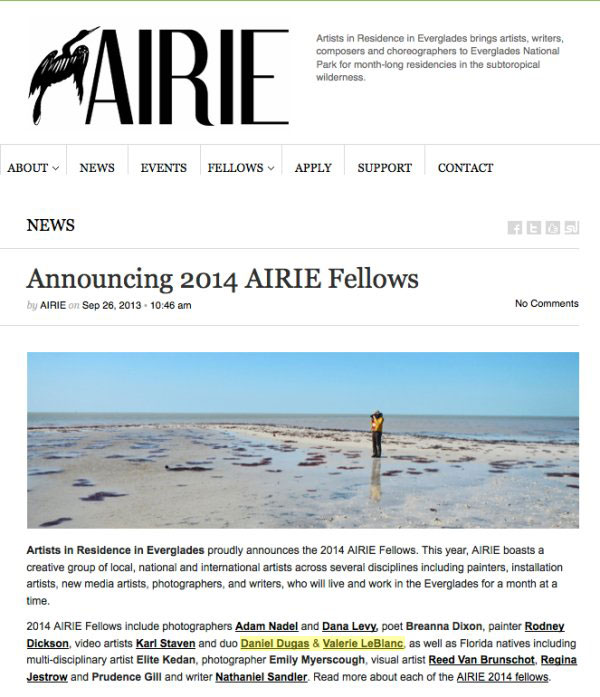
Artists in Residence in Everglades proudly announces the 2014 AIRIE Fellows. This year, AIRIE boasts a creative group of local, national and international artists across several disciplines including painters, installation artists, new media artists, photographers, and writers, who will live and work in the Everglades for a month at a time.
2014 AIRIE Fellows include photographers Adam Nadel and Dana Levy, poet Breanna Dixon, painter Rodney Dickson, video artists Karl Staven and duo Daniel Dugas & Valerie LeBlanc, as well as Florida natives including multi-disciplinary artist Elite Kedan, photographer Emily Myerscough, visual artist Reed Van Brunschot, Regina Jestrow and Prudence Gill and writer Nathaniel Sandler. Read more about each of the AIRIE 2014 fellows.
South Florida is home to the only subtropical wilderness area in the country, AIRIE is the only program bringing artists to the Everglades. AIRIE’s purpose is to inform, connect, and support artists, writers and musicians who wish to be inspired by the Everglades and then become ambassadors for the Park and its resources. AIRIE partners with Everglades National Park staff to offer month-long artist residencies in the Park’s subtropical wilderness. At least twelve AIRIE Fellows per year live and create new work in the Park, and in return lead interactive activities with visitors and donate artwork to the Park.
With generous support from the John S. and James L. Knight Foundation Arts Challenge Grant, AIRIE connects Fellows with the South Florida cultural community to bring attention to this unique and endangered part of our national heritage. AIRIE’s expanded programming will feature a year-round calendar of events both in the Everglades and outside the Park, including readings, performances, workshops and lectures. Through these outreach events, Fellows will use their art forms to engage the public, showcasing the Everglades as inspiring, important and worth protecting.
AIRIE Fellows have the unique opportunity to get to know the ecology of the Everglades by being immersed in it, and then share their perspective through creative public programs. “In a park known for its spectacular and diverse wildlife, the art and voices of AIRIE artists reveal other unique, and often missed, dimensions of this special place,” remarks Park Superintendent Dan Kimball.
from: http://airie.org/2013/announcing-2014-airie-fellow/
Daniel H. Dugas
Archives
Blogroll
- A.I.R. Vallauris
- ACAD
- Adobe additional services
- Adobe Creative Cloud
- AIRIE
- Amaas
- Amazon Author Central
- ARTothèque
- Australian Poetry
- Basic Bruegel
- Bitly
- CCCA
- CDBaby
- Cycling 74
- Dissolution
- Éditions Prise de parole
- Emmedia
- eyelevelgallery
- FAVA
- Festival acadien de poésie
- Festival FRYE Festival
- FILE – Electronic Language International Festival
- Freeware list
- Fringe Online
- Galerie Sans Nom
- Gotta Minute Film Festival
- Instants Vidéo
- JUiCYHEADS
- Kindle Direct Publishing
- Klondike Institute of Art and Culture
- La Maison de la poésie de Montréal
- La Maison de la Poésie et de la Langue française Wallonie-Bruxelles
- Laboratorio Arte-Alameda
- Le Centre Jacques Cartier
- Liberated Words
- Maison Internationale de la Poésie – Arthur Haulot
- MediaPackBoard
- Miami Book Fair International
- Monoskop
- Mot Dit
- NSCAD University
- Paved Arts
- PoetryFilm
- Portail des auteurs du Nouveau-Brunswick
- RECF
- Revue Ancrages
- Salon du Livre du Grand Sudbury
- Sculpture Space
- Subtropics.org
- Sydney college for the arts
- The Centre for Contemporary Canadian Art
- The New Gallery
- Trevigliopoesia
- tumbler-documents
- V Tape
- Valerie LeBlanc
- VideoBardo
- Void Network-Κενο Δίκτυο
Categories
- #covidpoèmes
- Advertisement
- AIRIE
- Ancrages
- anthology
- Anthropocene
- Architecture
- Around Osprey
- art
- Article de presse
- arts visuels
- audio
- Australian Poetry
- Basic Bruegel Editions
- Book
- book fair
- Cafe Poet Program
- Ce qu'on emporte avec nous
- Citations gratuites
- Collaboration
- commentaire
- commentary
- Compte rendu
- conférence
- Conservation Foundation of the Gulf Coast
- COVID-19
- Critique littéraire
- culture
- Daniel Dugas
- Design
- Édition Michel-Henri
- Éditions Perce-Neige
- Éloizes
- Emmedia
- emoji etc | émoji etc
- Environnement
- essai
- essay
- Everglades
- Exhibition
- festival
- Festival acadien de poésie
- Festival Frye Festival
- FIPTR
- Flow: Big Waters
- Fundy
- Habitat
- installation
- Instants Vidéo
- interactivity
- journal
- JUiCYHEADS
- Kisii
- L'Esprit du temps
- laptop
- Leaving São Paulo
- lecture
- Livre
- logos
- Magazine
- Miami Book Fair
- Moncton 24
- novel
- OASIS
- oil spill
- perception
- performance
- Photo
- poésie
- Poetic Licence Week
- Poetry
- politics
- politique
- press
- Prise de parole
- Revue Ancrages
- salon du livre
- sculpture
- Sculpture Space
- sound
- Souvenirs
- Spirit of the Time
- Style & Artifacts
- Symposium d'art/nature
- talk
- television
- The New Gallery
- Uncategorized
- Valerie LeBlanc
- vidéo
- vidéopoésie
- Videopoetr/Vidéopoésie
- videopoetry
- visual arts
- What We Take With Us
- youth literature






